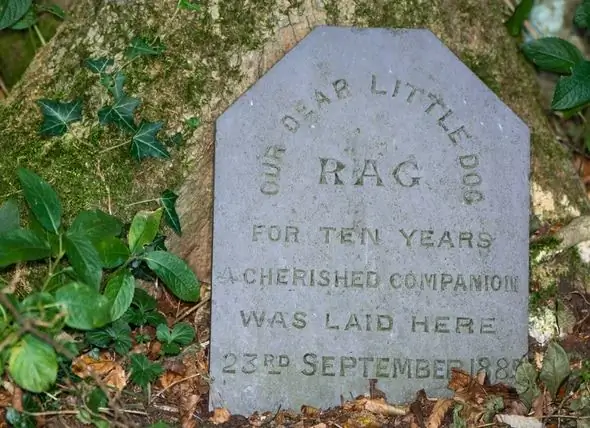
- Հեղինակ Daisy Haig [email protected].
- Public 2024-01-31 10:58.
- Վերջին փոփոխված 2025-06-01 06:47.
Ուրեմն ինչի՞ համար է այդ ամոթալի կակաոյի թեստը:
Բավականին սթրեսային է, որ ձեր ընտանի կենդանու հետևի մասը խախտվում է պլաստիկ ձողի միջոցով, այնպես չէ՞: Ի՞նչ իմաստ ունի:
Դուք ասում եք. Եթե իմ ընտանի կենդանուն առողջ և մակաբույծներից զերծ պահելու նպատակ կա, ապա ես կվստահեմ ձեր դատողությանը, բայց պետք է ասեմ, որ աթոռի ստուգումը մի տեսակ դաժան և անսովոր պատիժ է: Ես այդպիսի նվաստացում չեմ ստանում, մինչև ես արական և քառասուն տարեկան չլինեմ, չէ՞: Եվ կղանքներն այդքանո՞վ օգտակար չեն:
Ես ասում եմ. Սկսնակների համար հարկավոր չէ, որ ձեր ընտանի կենդանիները ենթարկվեն անառակ գավազանին: Թարմ նմուշը սովորաբար հեշտությամբ ձեռք է բերվում առավոտյան (կամ կեսօրին) ձեր տարեկան այցից առաջ կամ ցանկացած պահի, երբ ձեր ընտանի կենդանուն տառապում է ստամոքս-աղիքային ախտանիշներից: Իրոք, այնքան էլ կոշտ չէ: Եվ եթե ժամանակը ճիշտ չի համապատասխանում (աթոռը չպետք է գերազանցի մեկ ժամվա ընթացքում լավագույն արդյունքի հասնելու համար), ձեր անասնաբուժական հիվանդանոցը, անկասկած, չի մերժի ձեզ ՝ ձեր հարմարության համար գերթարմ նմուշ բերելու իրավունքը: Խոստում
Եվ այո, կղանքի հետազոտությունները, չնայած համեմատաբար էժան և սովորական են, անփոխարինելի են: Բայց ինչպես ցույց կտա այս հաղորդագրությունը, ճիշտ է նաև, որ ոչ բոլոր կղանքի թեստերն են ձեր կենդանիների մոտ պարազիտով վարակ վերցնում: Այդ պատճառով կարող են անհրաժեշտ լինել տարեկան և (կամ) սերիական կղանքի հետազոտություններ:
Այժմ թեստի հիմնական նպատակի համար.
Անասնաբույժները միշտ հետևում են մակաբույծներին, որոնք կարող են տեղ գտնել ձեր կենդանիների ստամոքս-աղիքային տրակտի մեջ: Իհարկե, մենք ՝ մարդիկ, նույնպես կարող ենք մակաբույծներ ձեռք բերել, բայց մեր ժամանակակից կենսակերպը սովորաբար ավելի քիչ է նպաստում մակաբույծների վարակմանը: (Ե՞րբ եք վերջին անգամ բակում խռխռացել, շրթունքները գետնին տանել, որպեսզի կարողանաք ներթափանցել կատվային տրդուկ կամ երկու):
Այո, ընտանի կենդանիները շատ մակաբույծներ են ունենում: Ահա ամենատարածված ստամոքս-աղիքային մակաբույծների ընտրանքը, որը ես տեսնում եմ այստեղ [մակաբույծների երկնքում, որը կիսաարևադարձային Հարավային Ֆլորիդա է]:
Կլոր որդեր շների ու կատուների մեջ:
Կենդանիներ կենդանիների մեջ
Whipworms ընտանի կենդանիներում
Iardիարդիան ընտանի կենդանիների մեջ

Կենդանիների կենդանիների լյարդի խառնուրդը
<գործչի դաս =" title="Պատկեր" />
Կենդանիների կենդանիների լյարդի խառնուրդը
coccidia in pets
i’ll not go into the gory details on each but you can click on the links and check out the info for a better understanding of how these parasites can potentially affect your pets and even your human family.
sure, pet-popular parasites don’t often infect humans in the so-called, “developed” nations all of you reading this likely live in, but that doesn’t mean it doesn’t happen. roundworms and hookworms are still a factor in humans in the us, as is giardia, which will give you the nastiest case of diarrhea you can imagine short of amoebic dysentery.
since veterinarians are also on the front lines when it comes to public health, consider that fecal exams are not just necessary for healthy pets, they’re essential for healthy humans, too, more so if your family members are very young children, very old adults or otherwise immunocompromised (transplant patients, hiv-positive humans, chemo recipients, etc.).
how do we identify these critters in the fecal exam?
the short answer: with a microscope.
the long answer: we take a tiny sample of your pet’s stool (very fresh is always best). a few grams is enough (think an eighth of a teaspoon if that’s easier). then we put it through one of three processes.
1. the smear: we take about a half gram of stool and smear it onto a microscope slide to search for parasites (and bacteria) directly. many times we’ll see them swimming about. finding evidence of parasites in a simple smear is often indicative of severe infection.
2. the float: this method relies on mixing the stool with a special solution. it filters out the big pieces of stool in a tube or other cylindrical vessel and allows the eggs and other small critters to float up to the top, buoyed by the solution’s specific gravity. a microscope slide’s cover slip is typically used to recover the floaters. some parasites, however, aren’t amenable to flotation. eggs seem to do best through this method.
3. centrifugation: spinning the heck out of stool in a centrifuge when it’s mixed in a sugar solution picks up about 50% more parasite eggs and oocysts than through flotation. therefore, i like this method best for worm eggs, giardia, and coccidia--though i’d never go without a smear. problem is, most hospitals don’t yet use this method. it’s more expensive than others and research demonstrating it’s much greater efficacy is fairly recent.
so now you know the truth: not all fecal exams are created equal. not only does this test rely on careful selection of materials and methods, it also requires a trained eye. in our practice, for example, one of our techs detects parasites about 50% more often than the veterinarians and other techs/assistants. (that’s why we also do floats so that she can check them all at her convenience when she comes back from her day off.)
it’s also true that even a parasite-infected animal will often not come up positive on a fecal test. human error and equipment choice are factors, but so is the parasite itself. sometimes they do not make themselves known in the stool. worms sometimes aren’t shedding their eggs and subclinical (low-grade or smoldering) infections may not reveal much, either.
again, that’s why it’s important to perform this test as often as is reasonable. for all dogs and cats at least three times during the first few months of life. i want to see at least two negative tests in a row, a month apart, before i’ll feel comfortable that my patient is parasite-free.
for adults, once a year is great--that is, unless they show gastrointestinal illnesses. in this case, serial fecal tests make sense--or at least one every time the symptoms recur until a definitive diagnosis is made (whether it’s parasites or something else).
ultimately, fecal tests are a critical component of our veterinary hat of tricks. doing without may seem like the economically wisest thing in the absence of gastrointestinal symptoms, but consider: parasites can wear pets down in ways you might not expect. and it’s never wrong to be too safe in the presence of diseases that may also affect your family. ‘nuff said.
Խորհուրդ ենք տալիս:
Ինչու է կարևոր ընտանի կենդանու հիշատակի արարողություն `ընտանի կենդանու կորուստը վշտացնելու համար

Կենդանին կորցնելը կարող է դժվար փորձ լինել: Կենդանիների հուշահամալիրի օգնությամբ դուք կարող եք տոնել ձեր ընտանի կենդանիների կյանքը այնպես, որ բուժում և փակվի
Կենդանիներ գիշերօթիկն ընդդեմ ընտանի կենդանիների նստելը. Որն է ավելի լավ ձեր ընտանի կենդանու համար

Ձեզ հարկավոր է մեկնել քաղաքից դուրս ՝ գործի, արձակուրդի, հարսանիքի կամ ընտանեկան հավաքույթի համար: Ձեր ամենամեծ մտահոգությունը ճանապարհորդության ծրագրերն է, թե ի՞նչ անել շան ու կատվի հետ: Արդյո՞ք նա ավելի լավ կփորձի մյուս կենդանիների և ամենօրյա խաղաժամանակի կողքին: Թե՞ նա չափազանց վախենալու է և սոցիալապես անկանխատեսելի է օտար միջավայրում և ավելի լավ կլինի տանը: Գիշերօթիկ կամ ընտանի կենդանիների նստելը, ո՞րն է պակաս սթրեսը բոլոր շահագրգիռ անձանց համար:
Ինչպե՞ս իմանալ, արդյոք ձեր ընտանի կենդանուն նեկրոբիայի կարիք ունի (իսկ ինչն է այնուամենայնիվ նեկրոպան):

Նեկրոզիա, կենդանիների դիահերձում, կենդանիներ, շուն, կատու
Ընտանի կենդանիների սնունդ (այն, ինչ դուք պետք է իմանաք) ձեր ընտանի կենդանու համար

Հետևյալ հաղորդագրությունների շարքը, որը կօգնի տնային կենդանիների սեփականատերերին ուսուցանել պիտակներ կարդալու և իրենց ընտանի կենդանիների համար վստահելի սնունդ ընտրելու մասին: Հեշտ է խաբվել շուկայավարման հնարքներով և պիտակի ապակողմնորոշիչ պնդումներով … ընտանի կենդանիները չեն կասկածում, թե ինչ են ուտում… ուստի մենք պետք է
Ավելի մաքուր, կանաչ տան ձեր և ձեր ընտանի կենդանու համար

Բոլոր թունավոր միջավայրերից, որոնց ենթարկվում է ձեր կենդանին իր կյանքի ընթացքում, այն վայրն է, որտեղ մենք մեզ առավել անվտանգ ենք զգում, որը կարող է ամենավտանգավորը լինել ձեր ընտանի կենդանու առողջության համար:
